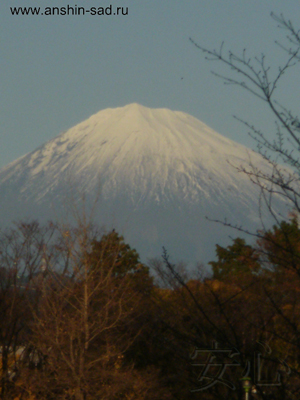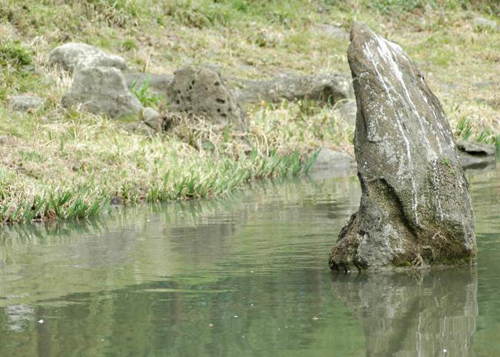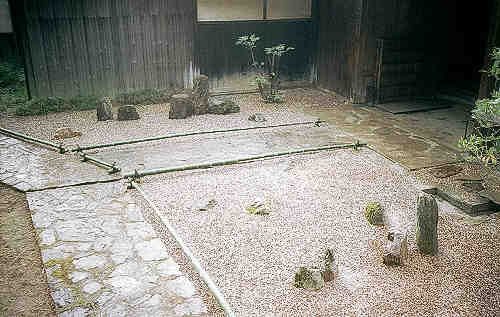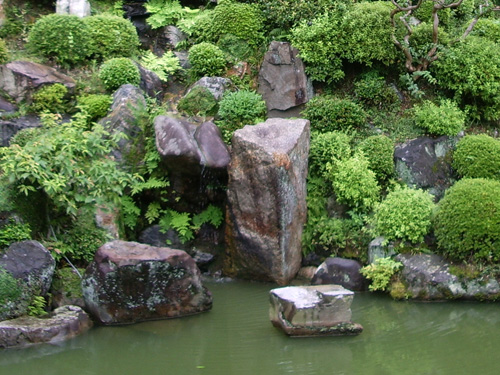
Pages of a Stone Book
There are not many mysteries in the images of stones.
The secret is revealed by one word - they are alive.
“The Mustard Seed Garden Manual of Painting”
“Pages of a stone book”… The people of older generation might still remember this wonderful book, where a boy from the stone ages tried to portray the life of his tribe on a rock. But stones themselves, especially garden stones, can tell you a lot. Their history is closely connected with the history of Japanese gardens and it would be interesting to follow this connection.
The people who lived in those distant times always remembered to treat everything around them like a living being. They believed stones were alive but lurking. Some stones were so alive that it was difficult for them to conceal their energy. People could feel it and considered them sacred. Later the Japanese called the energy ‘kisei’, i.e. strength of mind, and its manifestation in the visible world was known as ‘ikioi’. A man can perceive it through the shape, colour, texture - the combination of things which gives birth to beauty. People used to worship magnificent mountains, sparkling waterfalls, old, fancifully curved trees, unusual rocks- all what showed the beauty of nature. However, it was just rocks that caused most admiration.
Sacred Mount Fuji
At first, the people saw ‘kisei’ as sort of emanation influencing their minds. Later as abstract thinking was developing, people’s idea of the energy was changing, as the abstract substance was dividing into the spirits of individual items. Gradually they were becoming gods - kami. The god of the mountains Omo-no-nusi, that had the shape of a rock, appeared.
Omo-no-nusi
Along with some concrete items, an empty space could be an object of worship. It just had to be separated by a rope or several branches of an evergreen tree sakaki (Japanese cleyera), driven into the ground and covered with pebbles. Despite its small size, a pebble is also a stone and it can be very attractive. A god (not necessarily the god of the mountains) was considered to live on that area. Those grounds ‘shiki no himorogi’ eventually developed into Japanese gardens. So, it’s remarkable that a Japanese garden takes its origin from the sacred place.
Shiki no himorogi
Because of people’s attitude to the stones, it’s obvious that they took residence in the gardens, becoming more and more important. Some most impressive stones were respectfully set on artificial islands among the garden ponds, where they could symbolize sacred mount Shumeru. Some were arranged in the shape of sacred animals: a crane and a turtle, expressing longevity and the height of soaring of a human spirit. Others were put together in groups making beautiful compositions. However, stones became true masters of the garden in the late Middle ages in the so-called ‘rock gardens’, having ousted all the plants and even water which was imitated with the help of sand, gravel, pebbles and small flat stones.
Shumeru
It should be taken into account that Japanese garden stones are not those glacial waterworn boulders we’re used to, but they have sharp sides. The fact is, most Japanese rivers have their heads in the mountains and their fast flow carries along the stones, bringing them to the mouth of the river. Looking for pretty stones among all those which had been brought by the water and also revealing their beauty through their arrangement was what the Buddhist priests were doing. Those people were called ‘the monks negotiating with stones’.
Rock garden
One of the first garden creators who suggested using the stone in a different way was a zen monk, calligraphist, master of garden art Muso Soseki (1275-1351), also known as Kokushi. Kokushi means State guru, the title given by emperor Go-daigo. Muso Kokushi was the first man who pointed out the importance of a stone composition, which played the leading role in his works fitting naturally into the context of the garden. The beginning of the movement when people started to use some elements of their own design can be called an essential distinctive feature of that era. Developing in the direction of the symbolic image of nature, zen idealistic way of thinking along with the influence of Chinese landscapes led to the wide spread of ‘dry’ gardens. In the era of Heian a dry landscape was just one of the elements of a Japanese garden but soon it became a typical style of Japanese gardens.
Muso Kokushi’s innovations weren’t only connected with compositions of stones but also with their rock. Besides granite which was the most popular, Muso also breathed new life into the use of schist, which first had appeared in the gardens at the end of Heian era. After having that rock for a stone waterfall in Tenryuji Temple, the Japanese got interested in the colour of garden stones. Generally, three hues of colours became fashionable- pink, red and green, e.g. tall pink stones on an island of empire villa Katsura or a mosaic of small red stones on that very villa. Hasokawa Sansai (1563-1647), master of tea ceremony, the founder of bonsaki ‘Hasokawa’ school, was considered to intensify the colouring of one of the gardens by having sewn tiny red stones on the pebbles, which covered all the inner rodzi. Green stones were often used to build bridges and strengthen the shores of ponds. A ‘dry’ waterfall, which is alleged to be created by Kobori Enshu in temple garden Yogenin, looks impressive. There the streams are faced with small white quartz and there is one stone of red silica standing out against the snow-white rock. Along with one-colour ones, multicoloured stones appeared, e.g. xenolith which was fragments of the rock, aplites-granite rock with a typical saccharoidal structure, stones with white quartz veins, etc.
On the other hand a new attitude to the stones, caused by Muso Kokushi’s activity, pales before Kobori Enshu’s creative work. Kobori Enshu was one of the most outstanding Japanese architects, artists-ceramists and masters of tea ceremonies. He was believed to start a new era of the work with garden stones. Enshu was the first garden creator, who dared to change the nature according to his taste. No doubt people could change something but not to such a degree. Enshu shaped the objects into geometrical forms not typical in nature. There were cubic and prismatic stones, straight paths nobedan, small bridges and moorings made from granite slabs. The ponds, decorated with slabs, became rectangular. We are used to it now, but at those times that caused a furore. Using the so-called method of ‘comparison of natural and artificial’, when nature and geometrical objects are combined skillfully, Enshu created compositions full of hidden energy. Sento Cosho garden, whose pond is framed by rectangular granite slabs, or the waterfall of Tisyakuin garden with its granite rocks carved in the shape of a trihedral prism are bright examples. They don't look like a garden stones. They look like some constructive elements though.
Tisyakuin
All this changed drastically the idea of garden stones which had existed before. The times of the monks, negotiating with stones had passed. At the end of the 17th century the shops selling stones began to open. Nobody negotiated any more, the people just picked and sold the stones. The choice of which got wider, there was granite, granodiorite, schist, quartz of various colours, red silica and others. As a rule, the rocks were extracted far from Kyoto and the delivery cost a lot. It is said that at the time of ex-emperor Kokaku(1771-1840), Okubo Tadazane (1781-1837), the owner of Odawara castle, ordered to pick up pebbles on the coast, exchanging one pebble for 1,8 litre of rice.
However, Kobori Enshu’s works were not in vain. Some Japanese researchers consider him the forefather of modern constructivism in the gardening design as well as author’s design which is the only one nowadays.
Text - Alexandr Borisovich Zaitsev
Photo of Fuji - Alexsandra Shurupova
Other photos:
Omo-no-nusi, Shiki no himorogi, Shumeru, Rock garden, Muso Kokushi, Tisyakuin, Kobori Enshu
anshin©2011All rights reserved. When using the materials of the site, reference is obligatory.
Proposals for co-operation, as well as comments and suggestions on the site please send to the address: anshin-sad@mail.rutel: +7 (965) 121-80-60, 10am-20pm





